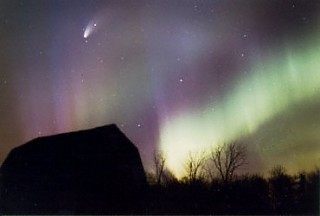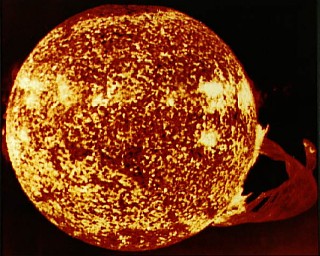|
|
 Two aspects of the solar wind are shown in
this photograph of comet Hale-Bopp. The tail of a comet faces away from the Sun,
because of the pressure of the solar wind on the dust particles in the comet's tail.
The aurora (northern lights) are caused by particles of the solar wind trapped by the
Earth's magnetosphere, interacting with oxygen (the red color) and nitrogen (the green
color) atoms about 150 km high in the Earth's atmosphere. |
Solar Wind
The solar wind is a stream of ionized particles – a plasma – that is ejected
from the Sun at high velocity. At the Earth's orbit the concentration of ions is
about 6 ions per cm3. This is a very small concentration, far, far less
than that of the best vacuum obtainable in labs on Earth.
The distribution of ions in the solar wind is close to the elemental composition of the
Sun. It is mostly protons, with about 5% helium and smaller fractions of oxygen and
other elements. There are electrons too, of course, counteracting the positive
charge of the ions and keeping the plasma electrically neutral. All this flows away
from the Sun with a mean speed of about 400 km/s (this is still far below the
speed of light which is 300 thousand km/s). The Voyager 2 space probe
showed that the solar wind extends past the outermost planets, and it probably continues
much further than that.
Just like the wind will act on a sailboat on Earth, huge sails have been proposed to
catch the solar wind. Even more creative ideas do not use a real sail at all, but
rather electromagnetic fields that would interact with the solar wind. Using the
solar wind one could accelerate a space craft to speeds near 300 thousand km/hr
before it left the solar system. Compared to the space shuttle's orbital velocity of
30 thousand km/hr this is almost a 10 times increase in speed.
However, the solar wind is not entirely beneficial. Since it consists of high
energy particles, it is a source of ionizing radiation. Outside of the shielding of
the Earth's magnetosphere, and atmosphere, astronauts are exposed to significantly higher
levels of radiation than on Earth. This is particularly serious during solar flares,
that can emit intense bursts of radiation. Because of the exposure to ionizing
radiation, it would be wise to keep the interplanetary travel time as short as
possible.


